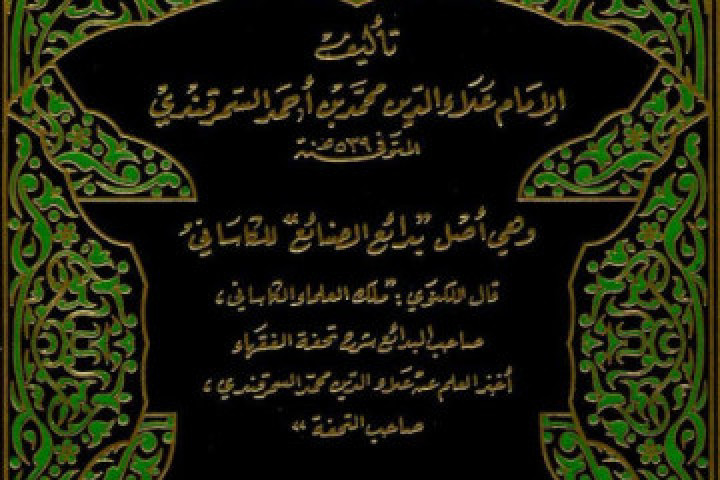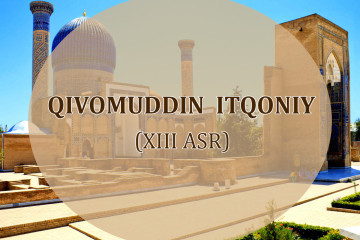
ALAUDDIN SAMARKANDI (died 539/1144)
Information about the life of the Hanafi jurist, whose full name is Abu Bakr Alauddin Muhammad ibn Ahmad ibn Abu Ahmad Samarkandi, is rare. In one of his works, he mentioned that hanafı scholar Fakhrulislam Abul Usr Bazdawi (d. 482/1089), who worked mainly in Samarkand, was his teacher. Tarajim sources mention that he was a student of the Hanafi scholar Abul Yusr Bazdawi (d. 493/1099) and the Maturidi theologian Abul Mu’in al-Nasafi (d. 508/1114). It is known that these two scholars mostly taught in Bukhara. Based on this information, W. Madelung came to the conclusion that his birth date cannot be later than 465/1073, and that after staying in Samarkand for a while, he went to Bukhara and completed his studies in the presence of these two scholars. Madelung also said that he lived in Anatolia for some time and may have gone to Konya.
It is mentioned that among his friends who studied with him in Samarkand were Abul Maali Ahmad ibn Muhammad Bazdawi, son of Abul Yusr Bazdawi, Hasan ibn Ali Bazdawi, son of Fakhrulislam Bazdawi, and Najmuddin Nasafi. There is no information about whether Alauddin Samarkandi worked in official positions. It is known that he was more engaged in teaching and writing books. Famous among his students are his daughter Fatima Samarkandiyya and Abu Bakr Kasani, who later became his son-in-law. Fatima memorized her father’s work called “Tuhfat al-Fuqaha” and started issuing fatwas together with her father.
Kasani, who studied under Samarkandi for a long time and read all his works, wrote the famous work “Bada'i' al-Sana'i'” based on the work of his teacher. Satisfied with his work, Alauddin Samarkandi married his daughter Fatima to him, accepted this work as a dowry, and after this marriage fatwas began to be issued under the joint signature of Samarkandi, Fatima, and Kasani. The teacher of Burhanuddin Marghinani, Ziyauddin Muhammad ibn Husayn Bandaniji, was also one of Samarkandi’s students.
One of his contemporaries, Abdulkarim Sam'ani, noted that Samarkandi died in Bukhara on the first of the month of 539 Jumada Al-Awwal (October 30, 1144). Sam'ani wrote that Alauddin Samarkandi, who was considered one of the leaders of Mawarannahr Hanafi scholars during the Karakhanid period, was an accomplished scholar in the fields of jadal, usul and kalam. Kasani recognizes him as an ascetic scholar and the leader of people of the Sunnah. In his time, Samarkandi was considered one of the greatest representatives of the Hanafi madhhab, especially in Samarkand.
His works
1. Tuhfat al-Fuqaha. This work is an important source on furu’ al-fiqh. It is known for its method, systematicity, and easy understanding in Hanafi literature. This work, written based on Quduri’s “al-Mukhtasar”, was written in order to illuminate topics not mentioned in Quduri, to provide evidence and to systematically explain them. Kasani wrote a work entitled "Bada'i' al-Sana'i'fi Tartib ash-Shara'i" based on the content of this work. Two separate critical editions of “Tuhfat al-Fuqaha” were made (Zaki Abdulbar, Damascus, 1958; Beirut, 1984; Qatar, 1987; Muntasir Kattani - Wahba Zuhaili. Damascus, 1964).
2. Mizan al-Usul fi Nataij al-Uqul. This is a book on usul al-fiqh, which is different from the Hanafi usul tradition and written with the content and method of usul works written by many mutakallims, and it reflects the jurisprudential and theological approaches of the Samarkand Hanafi-Maturidi School headed by Abu Mansur Maturidi. As the author noted in the preface and in the text, there are two versions of the work, detailed and abridged, and the abridged version has reached us (Zaki Abdulbar. Doha, 1984; Abdulmalik Abdurrahman Sa'di. Baghdad, 1987).
3. Sharh Ta'wilat al-Qur'an. It is a commentary on “Ta'wilat al-Qur'an” by Imam Maturidi. Although it is mainly composed of notes from Abul Muin Nasafi’s lessons on “Ta’wilat", the order and description of the work are related to Samarkandi. Manuscript copies of this work, which is one of the important sources of Maturidiyya doctrine, are available in various libraries (Süleymaniye Library. Hamidiyya, 176; Asad Afandi, 48; Jarullah Afandi, 51; Tashkent Institute of Oriental Studies, 3155, 3249).
ALAUDDIN SAMARKANDI
(died 539/1144)
Information about the life of the Hanafi jurist, whose full name is Abu Bakr Alauddin Muhammad ibn Ahmad ibn Abu Ahmad Samarkandi, is rare. In one of his works, he mentioned that hanafı scholar Fakhrulislam Abul Usr Bazdawi (d. 482/1089), who worked mainly in Samarkand, was his teacher. Tarajim sources mention that he was a student of the Hanafi scholar Abul Yusr Bazdawi (d. 493/1099) and the Maturidi theologian Abul Mu’in al-Nasafi (d. 508/1114). It is known that these two scholars mostly taught in Bukhara. Based on this information, W. Madelung came to the conclusion that his birth date cannot be later than 465/1073, and that after staying in Samarkand for a while, he went to Bukhara and completed his studies in the presence of these two scholars. Madelung also said that he lived in Anatolia for some time and may have gone to Konya.
It is mentioned that among his friends who studied with him in Samarkand were Abul Maali Ahmad ibn Muhammad Bazdawi, son of Abul Yusr Bazdawi, Hasan ibn Ali Bazdawi, son of Fakhrulislam Bazdawi, and Najmuddin Nasafi. There is no information about whether Alauddin Samarkandi worked in official positions. It is known that he was more engaged in teaching and writing books. Famous among his students are his daughter Fatima Samarkandiyya and Abu Bakr Kasani, who later became his son-in-law. Fatima memorized her father’s work called “Tuhfat al-Fuqaha” and started issuing fatwas together with her father.
Kasani, who studied under Samarkandi for a long time and read all his works, wrote the famous work “Bada'i' al-Sana'i'” based on the work of his teacher. Satisfied with his work, Alauddin Samarkandi married his daughter Fatima to him, accepted this work as a dowry, and after this marriage fatwas began to be issued under the joint signature of Samarkandi, Fatima, and Kasani. The teacher of Burhanuddin Marghinani, Ziyauddin Muhammad ibn Husayn Bandaniji, was also one of Samarkandi’s students.
One of his contemporaries, Abdulkarim Sam'ani, noted that Samarkandi died in Bukhara on the first of the month of 539 Jumada Al-Awwal (October 30, 1144). Sam'ani wrote that Alauddin Samarkandi, who was considered one of the leaders of Mawarannahr Hanafi scholars during the Karakhanid period, was an accomplished scholar in the fields of jadal, usul and kalam. Kasani recognizes him as an ascetic scholar and the leader of people of the Sunnah. In his time, Samarkandi was considered one of the greatest representatives of the Hanafi madhhab, especially in Samarkand.
His works
1. Tuhfat al-Fuqaha. This work is an important source on furu’ al-fiqh. It is known for its method, systematicity, and easy understanding in Hanafi literature. This work, written based on Quduri’s “al-Mukhtasar”, was written in order to illuminate topics not mentioned in Quduri, to provide evidence and to systematically explain them. Kasani wrote a work entitled "Bada'i' al-Sana'i'fi Tartib ash-Shara'i" based on the content of this work. Two separate critical editions of “Tuhfat al-Fuqaha” were made (Zaki Abdulbar, Damascus, 1958; Beirut, 1984; Qatar, 1987; Muntasir Kattani - Wahba Zuhaili. Damascus, 1964).
2. Mizan al-Usul fi Nataij al-Uqul. This is a book on usul al-fiqh, which is different from the Hanafi usul tradition and written with the content and method of usul works written by many mutakallims, and it reflects the jurisprudential and theological approaches of the Samarkand Hanafi-Maturidi School headed by Abu Mansur Maturidi. As the author noted in the preface and in the text, there are two versions of the work, detailed and abridged, and the abridged version has reached us (Zaki Abdulbar. Doha, 1984; Abdulmalik Abdurrahman Sa'di. Baghdad, 1987).
3. Sharh Ta'wilat al-Qur'an. It is a commentary on “Ta'wilat al-Qur'an” by Imam Maturidi. Although it is mainly composed of notes from Abul Muin Nasafi’s lessons on “Ta’wilat", the order and description of the work are related to Samarkandi. Manuscript copies of this work, which is one of the important sources of Maturidiyya doctrine, are available in various libraries (Süleymaniye Library. Hamidiyya, 176; Asad Afandi, 48; Jarullah Afandi, 51; Tashkent Institute of Oriental Studies, 3155, 3249).
Additional Information



 O`Z
O`Z
 РУ
РУ
 EN
EN
 العربية
العربية

Notes